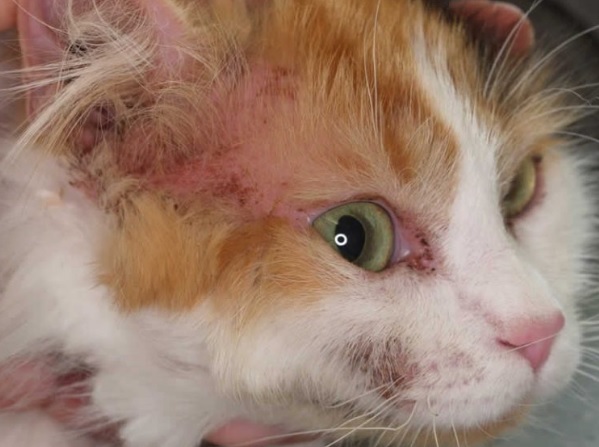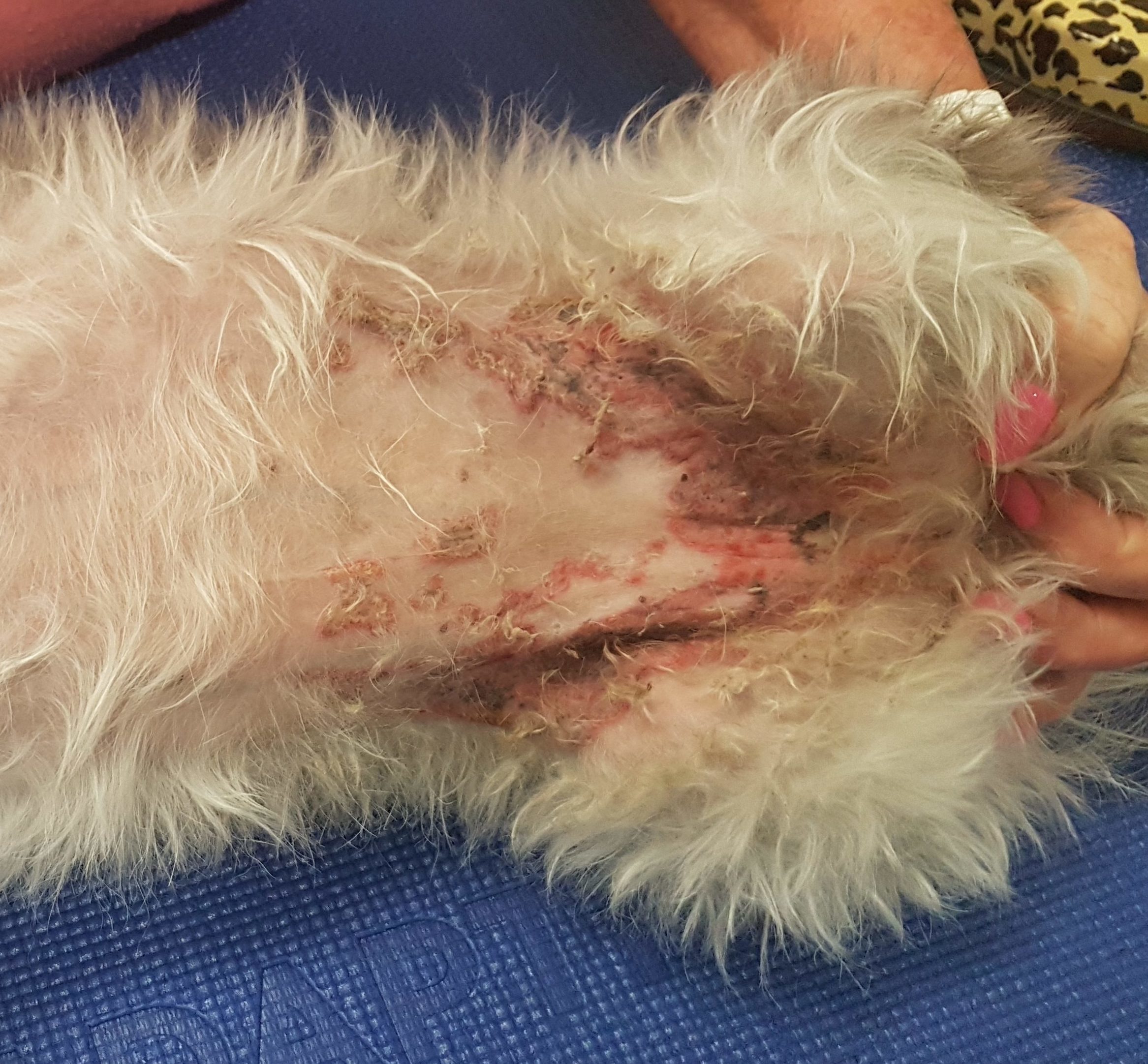Sparky, English Staffordshire Terrier, female, 5 years of age environmental allergies, “Atopic dermatitis.”
Sparky presented with a three year history of very itchy skin, which seemed to worsen a great deal in the spring and summer. She continually chewed her feet and scratched her trunk. Sparky responded well to medical treatment of her itch symptoms, but as soon as the medication was stopped, back came the itch. Her owners and their vet had tried so many treatments and were finding the itch very difficult to manage – she was scratching during the night at times, keeping her parents awake. Through the process of controlling infection and eliminating other potential allergies, Sparky was diagnosed as environmentally allergic. Intradermal skin testing was performed, and this showed strong allergic responses to several plants, weeds, moulds and insects. From this testing, a vaccine was manufactured to reduce Sparky’s reaction to these agents. Sparky has been receiving this vaccine for just over two years now, and only occasionally relies on medication to help with her itchiness. She is now a far more relaxed dog after 4 months on skin allergy vaccine.
Milly, Terrier crossbreed, female, 5 years of age. Chronic severe ear infections and foot chewing.
Milly presented with a two year history of recurrent, severe ear infections, and low grade chewing of her feet. This problem appeared when the owner’s moved from Townsville, QLD to Melbourne. Her owner had been to the vet on many occasions for this problem and had a full medical cabinet dedicated to managing the ear infections. This problem was beginning to change the shape of the ear canals and narrow their openings, making it difficult to apply medications to the ears. Microscopic examination of the discharge from the ears revealed there to be a stubborn type of bacteria infecting the ears. This has been successfully managed by initially cleaning the ears under general anaesthesia. 18 months down the track, and Milly’s ears are being successfully managed with ongoing, pulse therapy with special ear drops. Most cases of chronic ear infections have an underlying primary cause. In Milly’s case, this appears to be skin allergies. We are currently working to diagnose the cause of Milly’s allergies, and her itchy feet are easily managed with weekend-only medication.
Pronto, Irish Red Setter, male, 7 years of age. Testicular tumour and hair loss.
Pronto presented month duration of hair loss and flaky skin over his trunk. At the initial visit, unhealthy hair and skin flakes were literally covering the floor. Blood tests were all normal. Testicles were small, and one was every so slightly misshapen. Ultrasonography did not show testicular abnormalities. Laboratory analysis of both testes revealed both testes to have interstitial cell tumours, which lead to over production of male sex hormone, which can lead to alopecia. Since castration and support of the skin barrier, Pronto’s skin is gradually returning to normality.
Within 3 months, there is substantial regrowth and his hair is thickening and stronger. After the next hair moult it is expected that his haircoat will resume normality.
Frankie, domestic short haired cat, male, 5 years of age. Environmental allergy.
Frankie presented with 9 month duration of almost constant scratching. The skin over the neck, trunk and back legs was severely affected with scabbing and weeping sores. Frankie had experienced relief from his itch with antibiotics and cortisone from their local vet, but the relief was short-lived and restarted as soon as the medications stopped. The scratching was almost continuous. Through a step wise process, Frankie’s allergies were narrowed down to environmental allergies. Though we know that Frankie does have environmental allergies, in cats there is no reliable testing process to determine exactly what the causative allergens are. In dogs, this determination is far simpler. Frankie’s skin allergy management has come down to managing his itch symptoms, using medications that are far safer than cortisone. This has improved Frankie’s quality of life greatly, and is far easier for his owners to manage. Frankie’s owners are contemplating whether they may trial a skin allergy vaccine for him to de-sensitise him to his allergens. More on this in the near future.

Tina domestic medium haired cat, female, 4 years of age. Feline acne.
Tina presented with 5 months duration of pustules on her chin. This started out a black specks of what her owner and their vet thought was flea dirt, and then progressed to become widespread pimples and weeping pustules. In house sampling of the hair, skin and the discharge helped to rule out potential causes such as mite infestation, fungal and yeast infections. The bacterial infection that was present is associated with feline acne, which was her final diagnosis. In feline acne, the lesion starts out as many blackheads on the skin – which are plugs of keratin within the openings of the hair follicles. These follicles often become infected and will develop into swollen, draining sinuses. Initial medications to suppress the immune response were required. Topical antibiotic medication for several weeks allowed Tesco’s weeping sores to heal. Then to prevent ongoing blackhead formation, Tina owners to briefly clean her chin with medicated shampoo once to twice weekly. Tina’s chin is now back to normal.

Nino, Siberian Husky, male, 3 years of age. Zinc-responsive dermatosis.
At the time of our initial consultation, Nino had a 6-month history of inflammation, crusting and scaling around the mouth, muzzle, eyes, and ears. The condition had not responded to treatments at his regular vet. Skin biopsy supported the diagnosis of zinc-responsive dermatosis, which northern breeds of dog are genetically predisposed to. Nino’s skin condition responded very well to zinc supplementation, and oral fatty acid supplement also. This photo was taken part way through his therapy, with moderate improvement.
Jenna, Maltese x Shih Tzu Dog, female, 7 years of age. Erythema multiforme
Soon after a visit to her local emergency clinic for a gastrointestinal upset, Jenna’s skin began to show widespread erosion of the skin, especially in the areas without hair covering – her armpits and groin and lower abdomen. Skin biopsy revealed an immune -mediated skin disorder known as erythema multiforme, which may be triggered by certain viruses and medications.
Careful analysis of the emergency clinic’s patient history placed one of the less commonly used medications under suspicion as the precipitating cause. Three months after diagnosis, Jenna’s skin is healing well with the commencement of medication to suppress the adverse immune response, as well as regular use of surface treatments to assist skin restoration. 6 months after starting treatment her wounds are almost completely healed and her skin is much healthier.

















